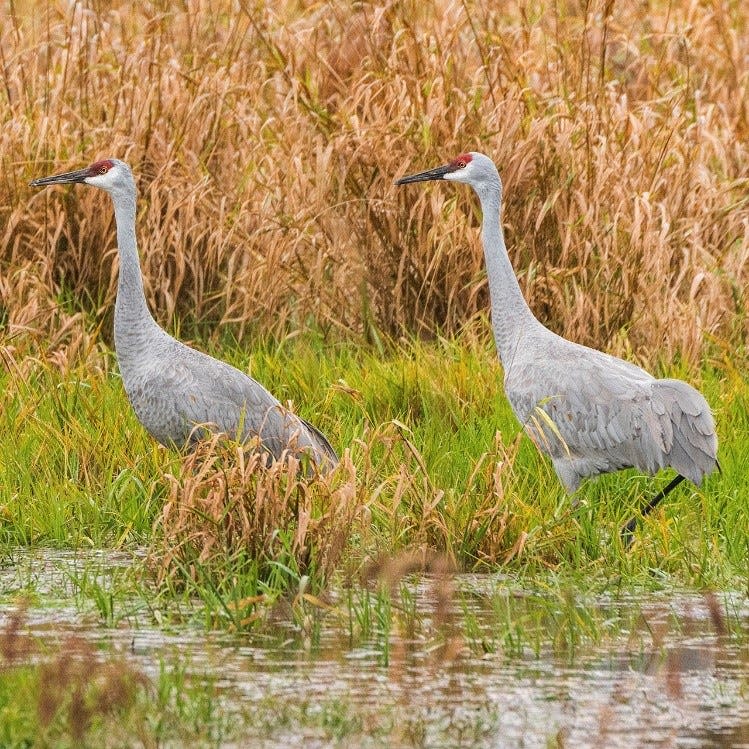Once near extinction, cranes are featured in a symposium at a Door County sanctuary
BAILEYS HARBOR - Bird watchers can learn about some feathered friends that once were on their way to extinction but are making their way back, at different rates, in a weekend of events at The Ridges Sanctuary that includes the chance to count the ones they see.

The Ridges is taking registrations for its second annual Crane Symposium being held from April 12 to 14. The symposium offers family-friendly hikes, presentations and a highly regarded keynote speaker to help participants expand their awareness and appreciation of Door County cranes. Sessions are geared toward learners of all ages.
“We are excited to offer information to hold the Crane Symposium for the second year,” Tony Kiszonas, director of research for The Ridges, said in a news release. “Continued education and awareness of cranes is crucial to their survival.”
Fifteen species of cranes are known to exist in the world, with seven listed as vulnerable, two as endangered and one (the Siberian crane) critically endangered by the International Union for Conservation of Nature's Red List of Threatened Species.
The two species native to Wisconsin are the sandhill crane and whooping crane. They once were widespread throughout North America, but destruction of the habitat and hunting had driven the species to the brink of extinction in the 1800s.
The 1916 Federal Migratory Bird Treaty Act, signed to protect the remaining birds in Wisconsin, Michigan, Minnesota and Ontario, along with conservation efforts from the International Crane Foundation, has led to a rebound in the species.
Today, Wisconsin’s sandhill crane population is making a successful comeback with an estimated at 60,000 to 70,000 in the state alone and 1.7 million across North America, according to the International Crane Foundation. Whooping cranes, however, have experienced a slower recovery with only 71 accounted for in Wisconsin, two in Illinois, two in Michigan and one in Minnesota, but their path is showing an upward trend.
The symposium kicks off at 6 p.m. April 12 with a keynote presentation (via Zoom) by Stanley Temple of the University of Wisconsin-Madison on "The Migratory Bird Treaty Act, Then and Now: Is it Still Working?" Temple will talk about the first century of migratory bird protection and speculate about its future, given ongoing challenges from loss and degradation of habitat, collisions with human-made structures, predation by cats, pesticide poisoning and oil spills.
Temple is the Beers-Bascom Professor Emeritus in Conservation in the Department of Forest and Wildlife Ecology at UW-Madison, as well as the former chairman of the Conservation Biology and Sustainable Development Program in the school's Gaylord Nelson Institute for Environmental Studies. He also is a Senior Fellow with the Aldo Leopold Foundation and has made important contributions to the study of numerous bird species.
The keynote program is free, but preregistration is required to get the Zoom codes to view it.
One of the highlights of April 13 activities is the chance to take part in the Midwest Crane Count from 5:30 to 7:30 a.m.
Sponsored by the International Crane Foundation, the annual count draws more than 2,000 volunteers who travel to local wetlands and favorite birding locations across the region to monitor the return of sandhill and whooping cranes to their northern breeding grounds. A free Crane Count Breakfast Social for participants to share sightings will follow at 8 a.m. in the Ridges' Cook-Albert Fuller Nature Center. To participate, email Tony Kiszonas at [email protected].
Other April 13 events are:
A crane nest site hike from 10 to 11:45 a.m., with naturalists Jane Whitney and Julie Knox leading hikers to potential nesting sites and discussing what makes the wetlands of Door County the perfect crane nesting habitat ($12 Ridges members, $15 nonmembers, $5 ages 16 and younger, preregistration required);
And an artist talk at 1:30 p.m. with internationally published photographer and Door County resident Len Villano reflecting on his journey photographing nature in Door County, emphasizing birds and sandhill cranes, with selected works on display during the symposium (free, but preregistration required).
The crane nest site hike will be held again at the same time April 14 and be joined by two children's events that day.
First is the "Chick Chats Story Hour" from 9 to 10 a.m. with stories on how sandhill cranes make the long journey north each spring. At the end of the story, a fun nature craft will be offered to take home or use on the Kids Birding 101 Hike that immediately follows. This event is free and suitable for families with young children.
Then, starting at 10 a.m., the Kids Birding 101 Hike offers families the chance to go birding together and learn the basic skills of birdwatching and how to identify common birds of Door County. It starts with an introduction at the nature center and continues down the Hidden Brook Boardwalk. Admission is free.
Founded in 1937 as Wisconsin’s first land trust, The Ridges Sanctuary is a 1,600-acre private, nonprofit nature preserve. It is listed as a National Natural Landmark, Important Bird Area and Wisconsin State Natural Area. Its nature center is at 8166 State 57, Baileys Harbor. For more information, call 920-839-2802; to register for Crane Symposium events, visit ridgessanctuary.org and click on the "Crane Symposium" chiclet on the right of the home page.
Contact Christopher Clough at 920-562-8900 or [email protected].
MORE: Door County voters, here's what you'll find on your ballots for the April 2024 election
FOR MORE DOOR COUNTY NEWS: Check out our website
This article originally appeared on Green Bay Press-Gazette: Once near extinction, cranes featured in symposium at The Ridges Sanctuary
